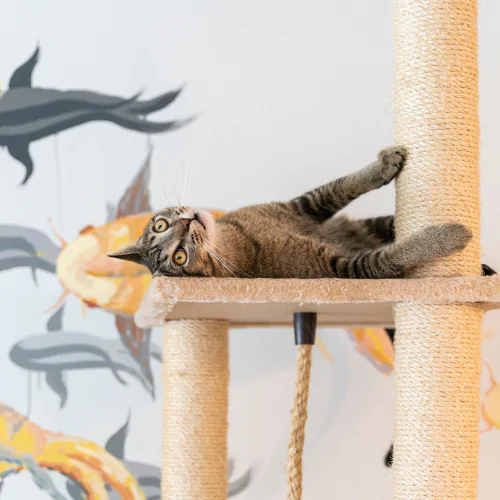
Fun cat enrichment ideas

Dr Jessica May, FirstVet vet
22 April 2022 | 8 minutes read
Just like their canine counterparts, cat care goes beyond their physical well-being. True, your kitty may be quite self-sufficient in many ways (and not want constant attention from you).
But this doesn’t mean you shouldn’t look for chances to give them plenty of stimulation. After all, one of the five freedoms of animal welfare is the freedom to express normal behaviour.
FirstVet vet Dr Jessica May shows felines the love they deserve by explaining why cat enrichment is important and sharing different ways to help them thrive.
- What is cat enrichment and why’s it important?
> Do indoor cats get depressed? - What are the different types of enrichment for cats?
> Environmental enrichment ideas for cats
> Social enrichment ideas for cats
> Cognitive enrichment ideas for cats
> Sensory enrichment ideas for cats - Does age and breed matter for cat enrichment?
- Cat enrichment toy ideas
> DIY cat enrichment toy ideas - How long should you play with your cat?
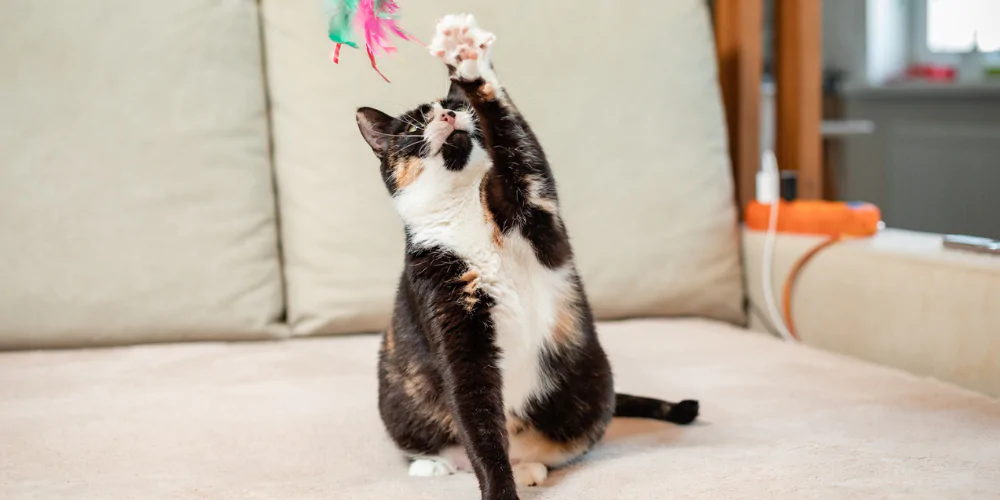
What is cat enrichment and why’s it important?
Cat enrichment is a way of helping felines to fight boredom and stress by giving them mental and physical stimulation. Introducing enrichment helps them explore their natural instincts in a positive and healthy way, which in turn encourages good behaviours. Even better, minimising stress (a common cause of behavioural and health issues) through enrichment can help cats live happier and more fulfilled lives.
Always remember to choose enrichments that suit your cat’s age, breed, and physical capabilities – but more on that later.
> Do indoor cats get depressed?
Many cat parents choose to keep their felines indoors if they live in a flat, near a busy road, or if it suits their breed temperament. But these kitties also still need an outlet for their natural behaviours – the ones which are often met by exploring and hunting outdoors.
So it’s extra important to give indoor cats enrichment and compensate for the lack of outdoor stimulation. If you don’t give them the chance to hunt, play, and scratch, they may become frustrated, leading to various behavioural issues like:
- Stress
- Depression
- Anxiety
- Soiling outside their litter box
- Scratching furniture
Housecats may get used to their non-changing indoor environment and become afraid of and overly sensitive to any changes. They could also struggle to escape stressful situations in a smaller, confined indoor space.
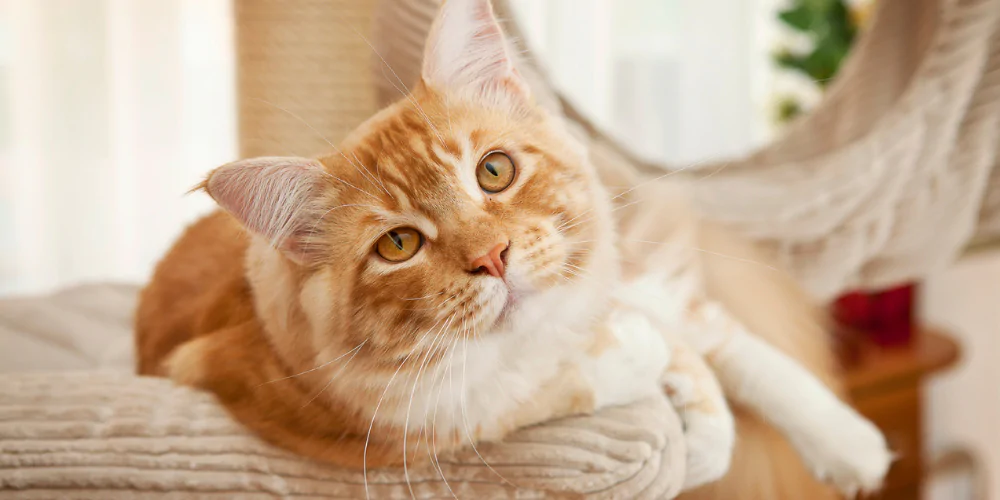
What are the different types of enrichment for cats?
Great news – you’re not short on options when it comes to enriching your cat’s life. There’s four main types of cat enrichment: environmental, social, cognitive, and nutritional. Try to bring in a mixture of activities from each to give your cat plenty of variety.
> Environmental enrichment ideas for cats
Turning your home into a cat play haven is a great way to give them environmental enrichment. You’ll want to create places where they can explore and hide, so they can have fun and still feel safe and comfortable.
Bring in environmental enrichments like:
- A catio or outdoor enclosure, so your indoor cat can safely and securely enjoy some fresh air.
- A cat tree or climbing pole, so they have plenty of active play and jumping.
- Perches near windows and in high up areas, so they can watch the world go by at a vantage point.
- Cardboard boxes and other hiding spaces (at least one for each cat), so they have somewhere to retreat when needed.
- Cardboard boxes and tunnels set up as playgrounds.
- Training them to use cat harness and lead (if they’re comfortable), so you can take them out for walks.
- Scratching posts and pads around the house, so they can have fun scratching without destroying your furniture.
- A cat-friendly garden, so they can explore their territory among safe plants and flowers.
- A private space for their litter box, so they feel safe when they need to go to the toilet.
- Ramps and steps if they’re older, so they can still get around the house without putting pressure on their joints.
- Plenty of active toys in different rooms, so they have lots of play options wherever they go.
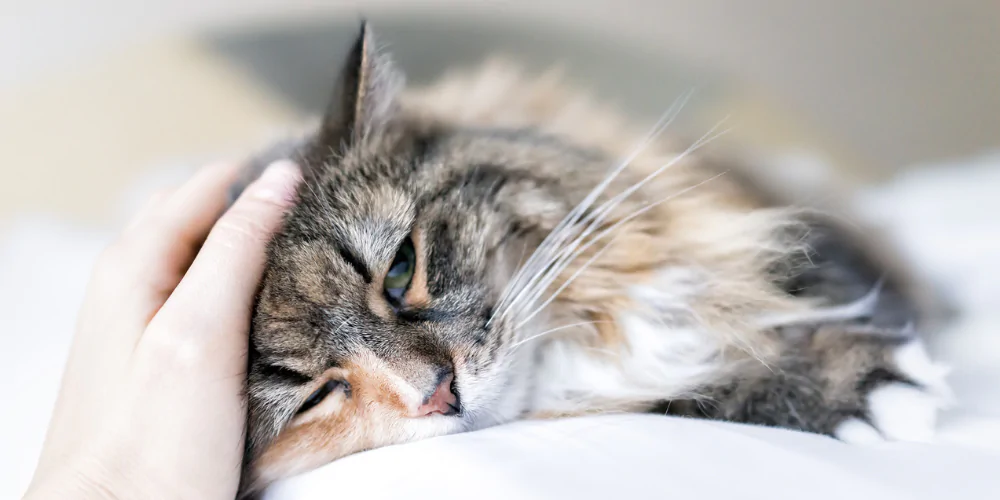
> Social enrichment ideas for cats
Cats thrive on social interaction, whether that’s with felines, other pets in the household, or their lifestyle patrons (also known as their owners). Cat social behaviours include playing, cuddling, and grooming, although each feline will have their own preferences.
Positive ways to interact with your feline include:
- Gentle and consistent handling, especially when they’re a kitten.
- Lowering yourself to their level and giving them time to initiate contact.
- Talking gently to them to help put them at ease.
- Petting around their head, cheek, and chin – they don’t enjoy being petted in other areas like the abdomen.
- Playing with them at a consistent time each day for a consistent period to create familiarity and routine.
- Learning their preferences and how much they like each kind of interaction, whether petting, playing, grooming, being picked up, or sitting on your lap.
- Giving them individual attention away from other cats in the house.
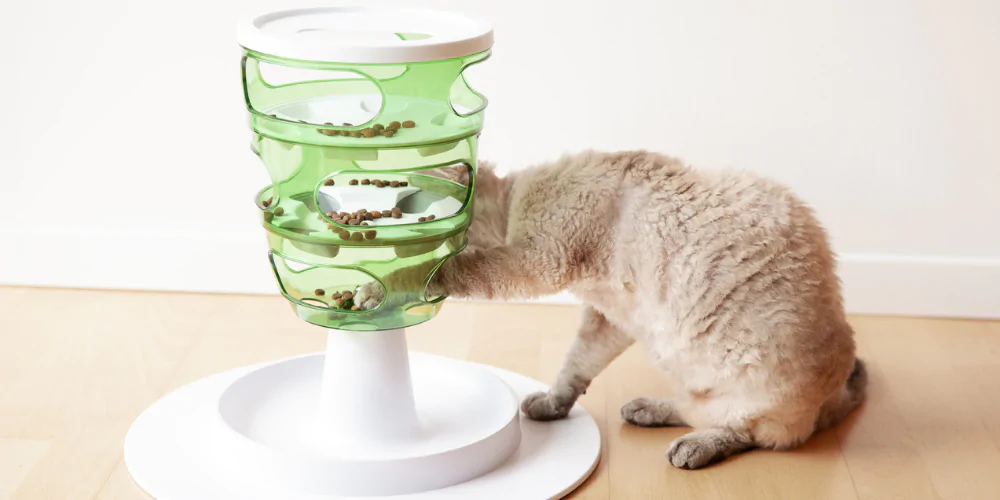
> Cognitive enrichment ideas for cats
Giving your cat plenty of play and feeding activities helps them to explore their natural predator instincts.
Try cat cognitive enrichment ideas such as:
- Hiding dry kibble around the house or scatter-feeding so they have to hunt and chase after their food.
- Putting their kibble in puzzle feeders and other mentally challenging toys.
- Hiding toys and food in cardboard boxes or other areas to encourage seeking and capturing.
- Rotating their toys to stop boredom from setting in.
- Giving them soft toys for biting, and furry or feathered toys to toss around like prey. Stay away from toys with small parts they could swallow.
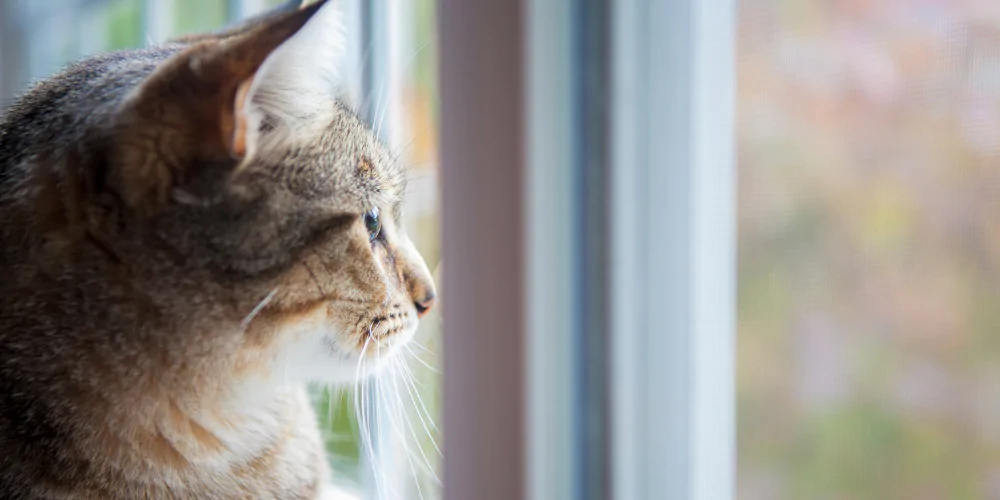
> Sensory enrichment ideas for cats
When it comes to sensory enrichment, you’ll want to appeal to all of your cat’s senses. We’re talking about a mix of sights, sounds, tastes, and smells that will keep your kitty’s curious mind stimulated.
Cat sensory enrichments could look like:
- Giving them scratching areas to deposit their scent through the glands in their paw pads.
- Placing a perch near a window for watching birds and other wildlife.
- Not using strong-smelling products, so other smells they recognise and associate with the house aren’t disrupted.
- Rotating bedding washes, so they always have some blankets or cushions with their scent.
- Taking care not to make sudden and loud noises that could frighten them.
- Introducing catnip toys and calming plug ins to help them relax.
- Giving them foods with different textures to liven up mealtimes.
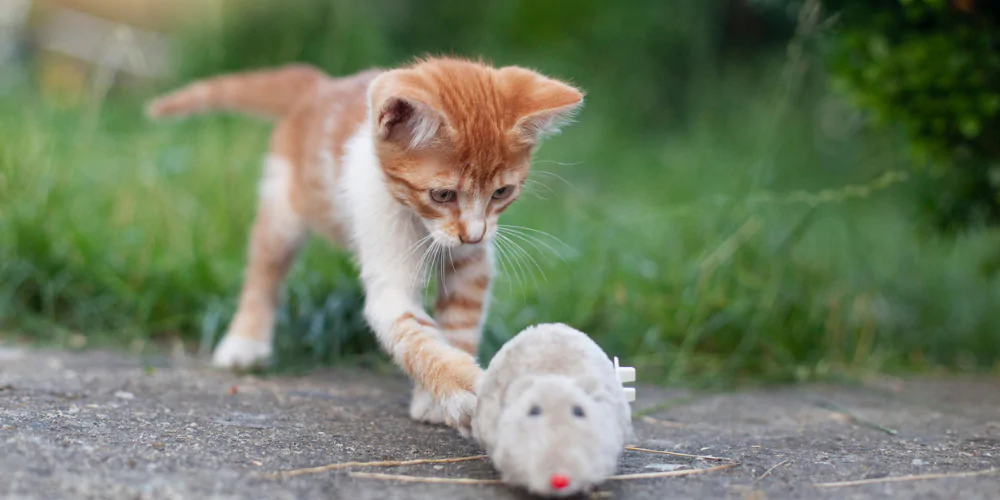
Does age and breed matter for cat enrichment?
Age and breed are both really important when it comes to choosing what kinds of cat enrichment you need for your feline.
For example, some breeds like the Persian and Maine Coone may want more social enrichment as they love cuddles and human interaction.
Kittens have a greater drive to play with other cats and want longer and more intense play sessions to burn off their energy. Being so little, they need size appropriate toys as well as ledges and perches at a lower height for easy access.
Older cats (as much as they wouldn’t admit it) need to go at a more gentle pace when playing. Ramps can help them get to their favourite perch spot or move ledges to a lower level for accessibility.
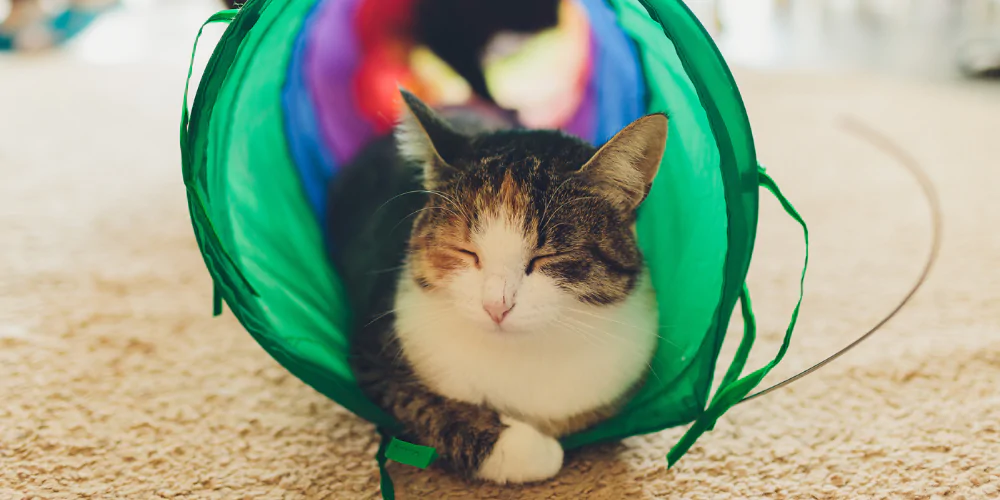
Cat enrichment toy ideas
our lucky feline is truly spoilt for choice when it comes to cat enrichment toys.
Just some of the toys you could get them are:
- Play and scratch posts
- Circuit toys with balls to push around inside
- Food puzzles and mazes
- Cat teasers and wands with feathers and rattle balls
- Motion-activated toys
- Catnip filled toys
- Laser lights (use carefully) to lead to a toy or food for handling
- Soft toys in the shape of prey animals
- Toys with rattle, crinkle, and squeaker sounds
- Play tunnels
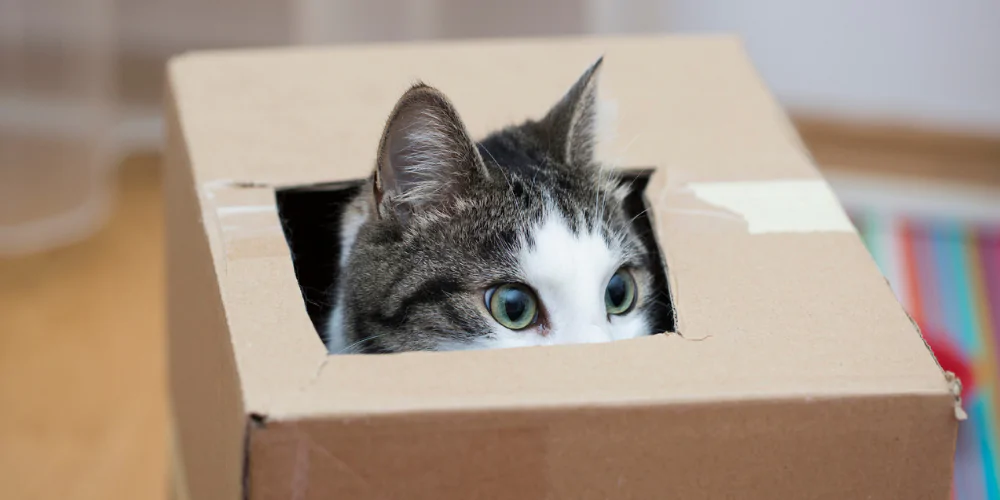
> DIY cat enrichment toy ideas
If you’re eco-conscious or love a good project, here’s some easy DIY cat enrichment toy ideas. Your cat may not acknowledge the effort put in, but you’ll feel good having made them something with love.
- DIY enrichment box – grab an empty cardboard box, drop toys and dry kibble in the bottom, and cover up with plenty of scrunched up newspaper.
- Muffin tin puzzle – put small treats or kibble inside each muffin holder. Cover up with a toy and watch your cat figure out how to move it to get to the treat underneath.
- Sensory box – grab a cardboard box big enough for your cat to sit comfortably inside. Add soft blankets or a pillow and add in textures and smells that help relax your feline.
- Foraging puzzle toy – Take an empty cardboard toilet roll, pop in some treats or kibble, and fold in the ends to close it up. Cut small holes along the sides so the treats fall out as your cat rolls the tube around.
For any food-based toys, remember to keep in mind your cat’s dietary needs.
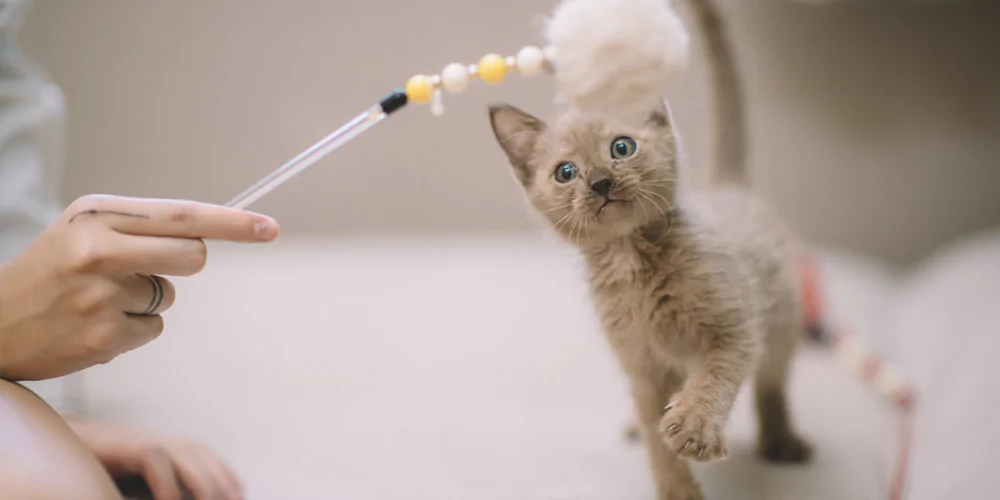
How long should you play with your cat?
Let your cat be the judge of how long and how often you play together. Every cat has their own preference on how much human interaction they enjoy.
Try out two or three play sessions during the day (at a consistent time of the day) and see how they respond. Some cats like short bursts of playtime throughout the day, while others like one long play session.
Don’t force things if your feline isn’t feeling it. When your cat walks away from you, that’s your cue to bring the play session to an end.
Helping your cat lead a happy life also means being prepared for when the unexpected happens. Protect your feline with flexible cat insurance from Petsure.


